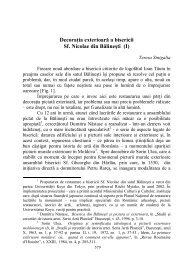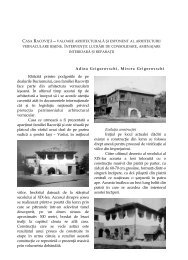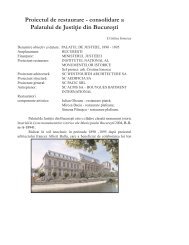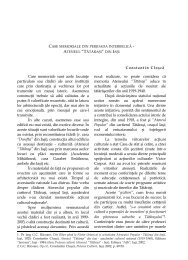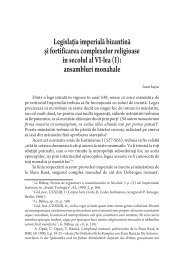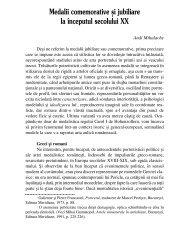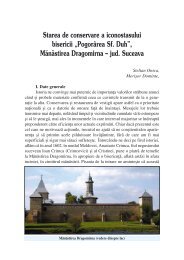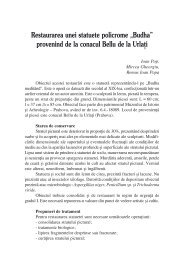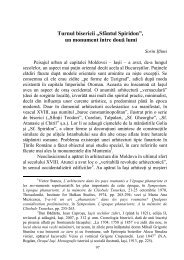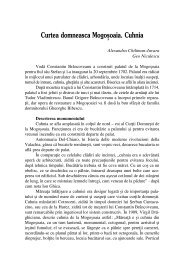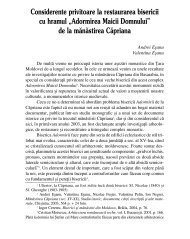utilizarea metodelor termice de analiză în ... - Monumentul.ro
utilizarea metodelor termice de analiză în ... - Monumentul.ro
utilizarea metodelor termice de analiză în ... - Monumentul.ro
You also want an ePaper? Increase the reach of your titles
YUMPU automatically turns print PDFs into web optimized ePapers that Google loves.
<st<strong>ro</strong>ng>în</st<strong>ro</strong>ng> timp prezintă modificări lizibile ale curbelor DTA cu vechimea. Acest<br />
lucru ar permite <st<strong>ro</strong>ng>utilizarea</st<strong>ro</strong>ng> lor <st<strong>ro</strong>ng>în</st<strong>ro</strong>ng> datare. Acest efect îl dau şi unele materiale<br />
anorganice, care “îmbătrânesc” prin modificări <st<strong>ro</strong>ng>de</st<strong>ro</strong>ng> alot<strong>ro</strong>pie, structurale sau<br />
compoziţionale. Pentru a putea utiliza curbele DTA sau DTG, <st<strong>ro</strong>ng>în</st<strong>ro</strong>ng> astfel <st<strong>ro</strong>ng>de</st<strong>ro</strong>ng><br />
expertize, trebuie să realizăm un mo<st<strong>ro</strong>ng>de</st<strong>ro</strong>ng>l matematic <st<strong>ro</strong>ng>de</st<strong>ro</strong>ng> <st<strong>ro</strong>ng>de</st<strong>ro</strong>ng>scriere intrinsecă a<br />
curbelor.<br />
În <st<strong>ro</strong>ng>de</st<strong>ro</strong>ng>scrierea matematică exactă a curbelor DTA există mari<br />
dificultăţi. Din cunoştinţele mele, nici o <st<strong>ro</strong>ng>de</st<strong>ro</strong>ng>scriere satisfăcătoare nu este<br />
completă. Până <st<strong>ro</strong>ng>în</st<strong>ro</strong>ng> prezent se cunosc <st<strong>ro</strong>ng>în</st<strong>ro</strong>ng>cercările lui Hodany [12], Barrai,<br />
Porter şi Jonshon [13,14], pentru cazuri <st<strong>ro</strong>ng>de</st<strong>ro</strong>ng> sisteme foarte simple. Este<br />
a<st<strong>ro</strong>ng>de</st<strong>ro</strong>ng>vărat că nu există acoperire nici teoretică nici experimentală pentru<br />
formulele empirice ce <st<strong>ro</strong>ng>de</st<strong>ro</strong>ng>scriu curbele DTA. Conform acestora, o astfel <st<strong>ro</strong>ng>de</st<strong>ro</strong>ng><br />
formulă este <st<strong>ro</strong>ng>de</st<strong>ro</strong>ng>rivată dintr-o curbă DTA foarte simplă (fig. 1.), cu un singur<br />
vârf endotermic, specific unei schimbări <st<strong>ro</strong>ng>de</st<strong>ro</strong>ng> entalpie, ce corespun<st<strong>ro</strong>ng>de</st<strong>ro</strong>ng> unei<br />
tranziţii alot<strong>ro</strong>pice şi unor modificări structurale simple (segregaţii, osmoze,<br />
difuzii, etc.).<br />
6<br />
Fig.1. Forma unei curbe DTA simple şi<br />
variaţia temperaturii ∆t, pentru un<br />
pigment mineral;<br />
Descrierea empirică a curbei DTA se poate realiza printr-un polinom<br />
cuadratic, <st<strong>ro</strong>ng>de</st<strong>ro</strong>ng> forma:<br />
2<br />
h = h0<br />
− at + bt , (1)<br />
<st<strong>ro</strong>ng>în</st<strong>ro</strong>ng> care, h – reprezintă distanţa <st<strong>ro</strong>ng>în</st<strong>ro</strong>ng> mm <st<strong>ro</strong>ng>de</st<strong>ro</strong>ng> la linia <st<strong>ro</strong>ng>de</st<strong>ro</strong>ng> bază (nivel 0° C),<br />
h0 este <st<strong>ro</strong>ng>în</st<strong>ro</strong>ng>ălţimea <st<strong>ro</strong>ng>în</st<strong>ro</strong>ng> mm la momentul 0, t - timpul <st<strong>ro</strong>ng>în</st<strong>ro</strong>ng> minute, iar a şi b<br />
reprezintă constante evaluate din date experimentale, a fiind exprimat <st<strong>ro</strong>ng>în</st<strong>ro</strong>ng><br />
mm/min şi b <st<strong>ro</strong>ng>în</st<strong>ro</strong>ng> mm/min 2 .<br />
Conform unui astfel <st<strong>ro</strong>ng>de</st<strong>ro</strong>ng> polinom momentul tm, exprimat <st<strong>ro</strong>ng>în</st<strong>ro</strong>ng> minute,<br />
aparţinând vârfului va fi:




